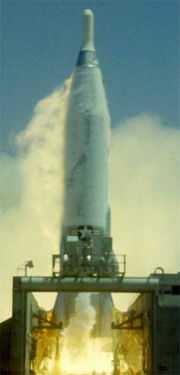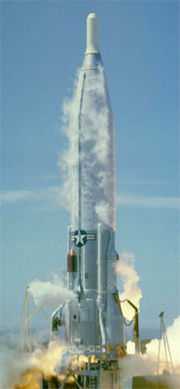SM-65E Atlas
 Launch of an Atlas-E missile | |
| Function | ICBM Expendable launch system |
|---|---|
| Manufacturer | Convair |
| Country of origin | United States |
| Launch history | |
| Status | Retired |
| Launch sites | LC-11 & 13 CCAFS OSTF-1, LC-576 & SLC-3, VAFB |
| Total launches | 48 |
| Successes | 33 |
| Failures | 15 |
| First flight | 11 October 1960 |
| Last flight | 24 March 1995 |
The SM-65E Atlas, or Atlas-E, was an operational variant of the Atlas missile. It first flew on 11 October 1960, and was deployed as an operational ICBM from September 1961 until April 1966. Following retirement as an ICBM, the Atlas-E, along with the Atlas-F, was refurbished for orbital launches as the Atlas E/F.[1] The last Atlas E/F launch was conducted on 24 March 1995, using a rocket which had originally been built as an Atlas-E.
As fully operational ICBMs, the Atlas E and F (which differed only in guidance systems) had upgraded engines and inertial control instead of the Atlas D's radio ground guidance.
Atlas-E launches were conducted from Cape Canaveral Air Force Station, at Launch Complexes 11 and 13, and Vandenberg Air Force Base at OSTF-1, LC-576 and SLC-3.[1]
The first Atlas E launch attempt was carried out from LC-13 at Cape Canaveral on October 11, 1960. It and the second launch on November 30 both failed due to loss of sustainer engine hydraulic pressure at around one minute into the flights. Flight #3 on January 24, 1961 was lost due to a control problem with the vernier engines. The fourth attempt on February 24 was successful and the fifth and sixth tries in March were partial successes.
After two successful Atlas E flights in May, testing at Vandenberg AFB in California began. On June 7, an attempt to launch Missile 27E from a coffin silo failed when the vehicle suffered combustion instability and exploded at liftoff, putting the pad out of commission for six months. This was followed by another failure at Cape Canaveral two weeks later when Missile 17E went out of control and disintegrated 30 seconds after launch.
As the June 1961 accident had curtailed launches at Vandenberg until Complex OSFT-1 could be repaired, subsequent Atlas E flights during the year took place from Cape Canaveral and most of them were successful. But in November, an attempt to launch a biological mission with a squirrel monkey named Goliath ended in disaster as the Atlas's sustainer engine and verniers shut down almost immediately at liftoff. The booster engines managed to retain attitude control until a fire broke out in the engine compartment and caused the right booster engine to shut down followed by loss of electrical power. With all control lost, the Atlas was destroyed by Range Safety at T+33 seconds (Goliath survived the explosion of the Atlas, but was killed on impact with the ocean; the capsule and its unfortunate passenger were recovered three days later). Despite these mishaps, the Atlas E was declared operational that month.[2]
The Atlas E and F were phased out of use as operational ICBMs in 1965 and replaced by the hypergolically-fueled Titan II. Decommissioned Atlas missiles were then used for military satellite launches well into the 1990s.
See also
References
- ↑ 1.0 1.1 Encyclopedia Astronautica - Atlas
- ↑ https://docs.google.com/viewer?a=v&q=cache:l1YjtRZxeEMJ:www.dtic.mil/dtic/tr/fulltext/u2/843200.pdf+atlas+32e+launch+report&hl=en&gl=us&pid=bl&srcid=ADGEESg1Gx3UFypEA9BHybyEwN76n3FHG_TL4XTVoOkbYVDe3PHCcMrXzk8eUgIoGvzGw53LhU17qCF_LvcZdruGn5jTI0hqLgm6O3RtDf3FEVqSETVaGyScrw1wWoyD_K_rXdM8Vvdq&sig=AHIEtbQ9bNKDjcjqZzJCKVMZvuhe4Jh7RQ
| ||||||||||||||||||||||||||||||||||||||||||||||||||||||||||||||||||||||
